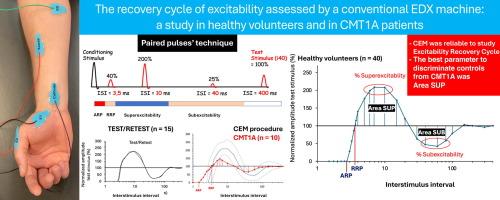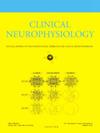The recovery cycle of excitability assessed by a conventional electrodiagnostic machine: A study in healthy volunteers and in Charcot-Marie-Tooth 1A patients
IF 3.7
3区 医学
Q1 CLINICAL NEUROLOGY
引用次数: 0
Abstract
Objective
To validate the ‘paired pulses’ technique with a conventional electrodiagnostic machine (CEM) for studying the axonal excitability recovery cycle (ERC).
Methods
Paired pulses, with a variable inter-stimulus interval, were delivered at the wrist along the median nerve. The CEM repeatability was verified in a group of 15 healthy volunteers (test/retest analysis). ERC was then applied in 40 healthy volunteers and 10 patients with Charcot-Marie-Tooth type 1A (CMT1A), using both the threshold tracking (TT) reference method and CEM (basal condition, during and after ischemia).
Results
CEM parameters evaluating absolute refractory and supernormal periods were reproducible (interclass correlation coefficient > 0.75). CEM results were consistent with TT method and literature data. In CMT1A, refractory and superexcitable periods were significantly reduced. According to receiving operator characteristic analysis, the CEM supernormal period area was the most relevant parameter for discriminating CMT1A from healthy volunteers (area under the curve = 0.98).
Conclusions
CEM was a valid procedure for studying ERC. CMT1A patients exhibited ERC alterations due to modifications in passive membrane properties and of nodal ion channel distribution resulting from demyelination.
Significance
Studying ERC with CEM could be performed in routine practice in patients with peripheral neuropathies to provide information on motor axonal excitability.

传统电诊断仪评估的兴奋恢复周期:对健康志愿者和 1A 型夏科-玛丽-牙病患者的研究
目的 验证 "成对脉冲 "技术与传统电诊断仪(CEM)在研究轴突兴奋性恢复周期(ERC)方面的效果。方法 在腕部沿正中神经发出刺激间隔可变的成对脉冲。在 15 名健康志愿者中验证了 CEM 的可重复性(测试/重测分析)。然后在 40 名健康志愿者和 10 名 Charcot-Marie-Tooth 1A 型(CMT1A)患者中使用阈值跟踪(TT)参考方法和 CEM(基础状态、缺血期间和缺血后)进行了 ERC。CEM 结果与 TT 方法和文献数据一致。在 CMT1A 中,不应期和超常期明显缩短。根据接收操作者特征分析,CEM 超常期面积是区分 CMT1A 和健康志愿者的最相关参数(曲线下面积 = 0.98)。CEM是研究ERC的有效方法。CMT1A患者表现出的ERC改变是由于脱髓鞘引起的被动膜特性和结节离子通道分布的改变。
本文章由计算机程序翻译,如有差异,请以英文原文为准。
求助全文
约1分钟内获得全文
求助全文
来源期刊

Clinical Neurophysiology
医学-临床神经学
CiteScore
8.70
自引率
6.40%
发文量
932
审稿时长
59 days
期刊介绍:
As of January 1999, The journal Electroencephalography and Clinical Neurophysiology, and its two sections Electromyography and Motor Control and Evoked Potentials have amalgamated to become this journal - Clinical Neurophysiology.
Clinical Neurophysiology is the official journal of the International Federation of Clinical Neurophysiology, the Brazilian Society of Clinical Neurophysiology, the Czech Society of Clinical Neurophysiology, the Italian Clinical Neurophysiology Society and the International Society of Intraoperative Neurophysiology.The journal is dedicated to fostering research and disseminating information on all aspects of both normal and abnormal functioning of the nervous system. The key aim of the publication is to disseminate scholarly reports on the pathophysiology underlying diseases of the central and peripheral nervous system of human patients. Clinical trials that use neurophysiological measures to document change are encouraged, as are manuscripts reporting data on integrated neuroimaging of central nervous function including, but not limited to, functional MRI, MEG, EEG, PET and other neuroimaging modalities.
 求助内容:
求助内容: 应助结果提醒方式:
应助结果提醒方式:


